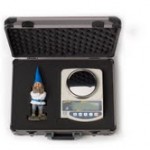
A plastic garden gnome is travelling around the world to help demonstrate how the pull of gravity changes in different locations.
Gravity is the force that attracts a person or an object to the centre of the Earth. It keeps us on the ground, and it also determines how much we weigh.
Gravity may be slightly stronger or weaker depending on where you are, which means things weigh different amounts in different places on Earth.
The difference is so small – 0.5 per cent or less – that most people using ordinary scales wouldn’t even notice it.
For example, if you weigh 40 kilograms, the difference would be no more than 200 grams higher or lower, depending on where you were.
But even such a small difference would matter to scientists who need to be very accurate when measuring amounts of chemicals for an experiment or comparing weights of different objects.
A company called Kern & Sohn makes very precise scales that are used in laboratories. They decided to do an experiment that would draw attention to the differences in gravity, so they are sending the gnome, along with a set of their scales, to be weighed by scientists around the world.

The gnome, nicknamed Kern, started its journey last October in Balingen, Germany, where it weighed 308.26 grams. Since then it has visited many places, including Peru, Japan, Australia, India and England.
So far, it has weighed the least in Mexico City, Mexico, (307.62 grams) and the heaviest at the South Pole (309.82 grams).
One reason for differences in gravity is the shape of the Earth. The Earth is not perfectly round. It bulges in the middle, so the North and South Poles are closer to the centre of the Earth than the equator is. That makes the pull of gravity stronger at the poles, so things weigh more there.
Gravity is also affected by altitude (how high up you are), geology (the type and denseness of rock under you), and whether there are mountains or valleys close by.
On March 23, the gnome visited SNOLAB, an underground laboratory in Lively, Ont. It weighed 307.73 grams on the surface and 307.63 grams in the lab, which is two kilometres underground. Scientists say the gnome weighs less underground because the rocks above the lab have their own gravitational effect which pulls it away from the centre of the Earth.
Related websites
Gnome Experiment (Details of the experiment plus a map with weights)
Note: This link was wrong (sorry about that), but we’ve fixed it. It’s worthwhile checking it out!
Travel Blog (The gnome’s travel blog)
CURRICULUM CONNECTIONS
By Kathleen Tilly
Writing/Discussion Prompt
Can you imagine what life would be like without gravity? How would your day be different if you woke up to discover that gravity had failed?
Reading Prompt: Text Features
Follow the link above and go to the gnome’s travel blog (the link is right above the curriculum connections). Take some time to skim and scan the blog.
How is a blog post different from a newspaper article? Pay close attention to text features, such as headings/subheadings, captions, labels, key words and phrases.
Which format do you find easier to understand: a blog or an article? Why?
Junior
Identify a variety of text features and explain how they help readers understand texts (OME, Reading: 2.3).
Intermediate
Identify a variety of text features and explain how they help communicate meaning (OME, Reading: 2.3).
Grammar Feature: Silent letters in words
The word, gnome, includes a silent letter ‘g’. This means you don’t pronounce the ‘g’ when you say the word.
What other words do you know that include a silent letter?








